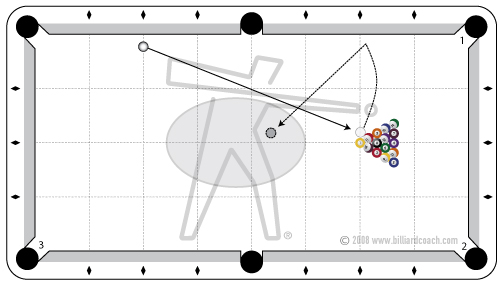Part II
© 2008 Mike Fieldhammer, BilliardCoach.com
Part I of the break shot details the most common approach to breaking by hitting the ball at the apex of the stack. This article will detail a highly effective alternative—the second ball break.
As summarized in part I, a successful break shot can be defined as follows:
• One or more balls have been pocketed
• The cue ball is in a position that offers an opening shot
• Object balls have scattered sufficiently and few clusters exist
The second ball break still benefits from a tight rack, but is more forgiving. One of the two balls directly behind the apex ball is struck and the action of the rack can be thought of as an explosion from the center of the rack. Energy from the cue ball is directed at the core of the rack with the object balls scattering from the inside out.
This concentrated strike is more of a sniper shot than an all out blast. Accuracy supercedes power in the second ball break. English and spin are employed to make aiming at the small target even more difficult. The power of the stroke must be held in check so as not to sacrifice a deadly accurate hit.
The cue ball must originate from near one of the side rails. This offers the shortest path and most advantageous angle to hit the second ball as full as possible. The cue ball should miss the apex ball and impact the second ball back. Clipping the head ball may cause a scratch in pocket ‘1’ or even jump the cue ball off the table. Steering too far clear of the head ball can be costly as well. Hitting too thin (low) on the second ball can send the cue ball straight into the corner or into the long rail and across to scratch in corner pocket ‘2’. Even if the scratches are avoided, you may be stuck beneath the stack or on the foot rail with no shot at all.
Outside English and draw (Low left in the diagram breaking from the left side rail) should be used in moderation to contact the side rail and direct the cue ball to the shaded oval position zone. As in the head ball break, the center of the table will offer the most options for an opening shot. Don’t overdo the low, outside spin because a scratch in pocket ‘3’ is possible. Cue ball kisses are highly likely, but if the cue ball is sent along the path illustrated the kiss may not hurt you. Keeping the cue ball away from the pockets greatly reduces the chance of getting kissed into a scratch.
Players new to the second ball break should begin without employing any left or right spin. Play the shot with draw only and focus on an accurate hit on the second ball. Some players have great success without adding the sidespin and hitting the break with high speed. Equipment and playing conditions may influence how you choose to shoot the second ball break shot.
This alternate break shot works well, especially when the head ball smash break is not satisfying the first two goals of breaking. You’ll often make a ball but may face a more difficult run out due to a less effective spread of the rack. This can be a smart move if you’d like to avoid leaving the rack wide open for your opponent to run out after a dry head ball break. Your opponent may have more work to run out a second ball break if you fail to make a ball.
Spend time working on powerful but controlled head ball breaks as well as the precision second ball break. Having two effective break shots in your arsenal will make you a more deadly run out weapon. Choose your break shot based on results of warm up games, table conditions, and what you observe from other skilled players. Getting an opening shot is the first step to running racks. Break well!

Leave a Reply